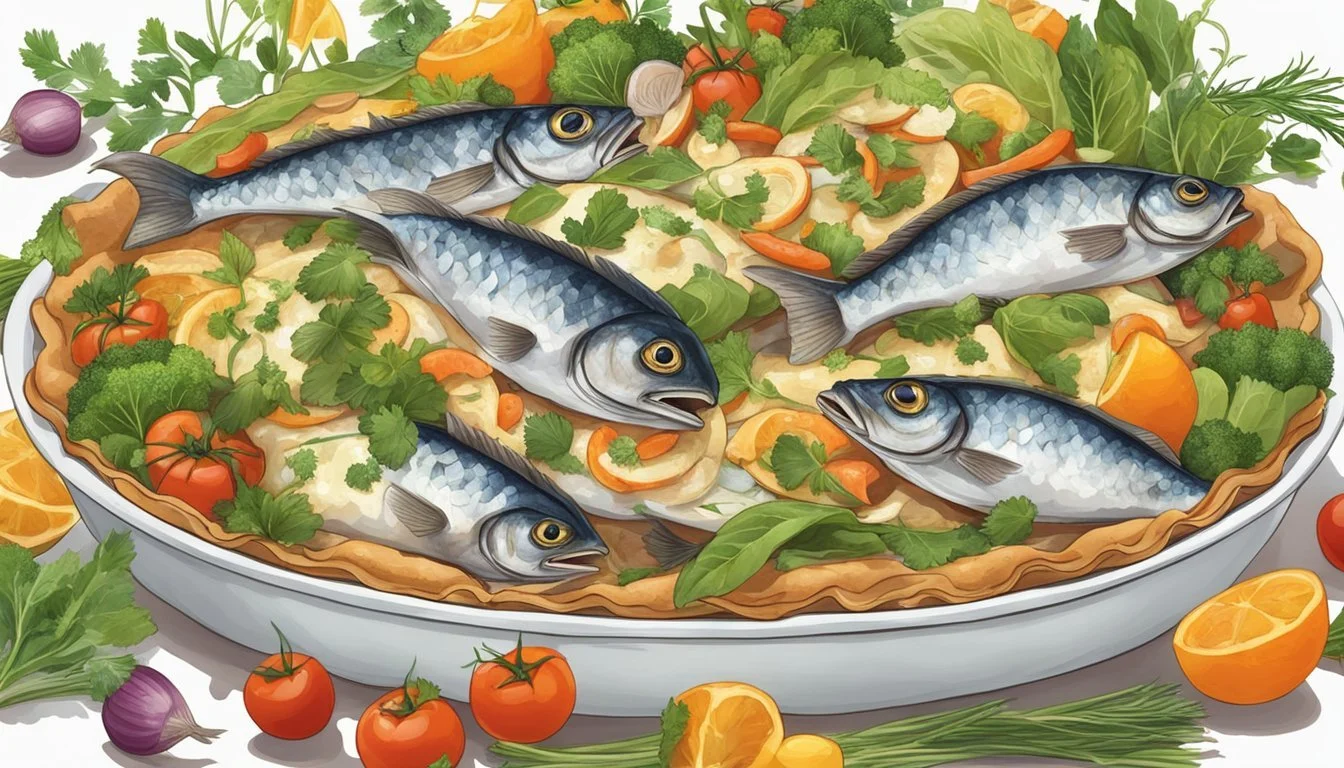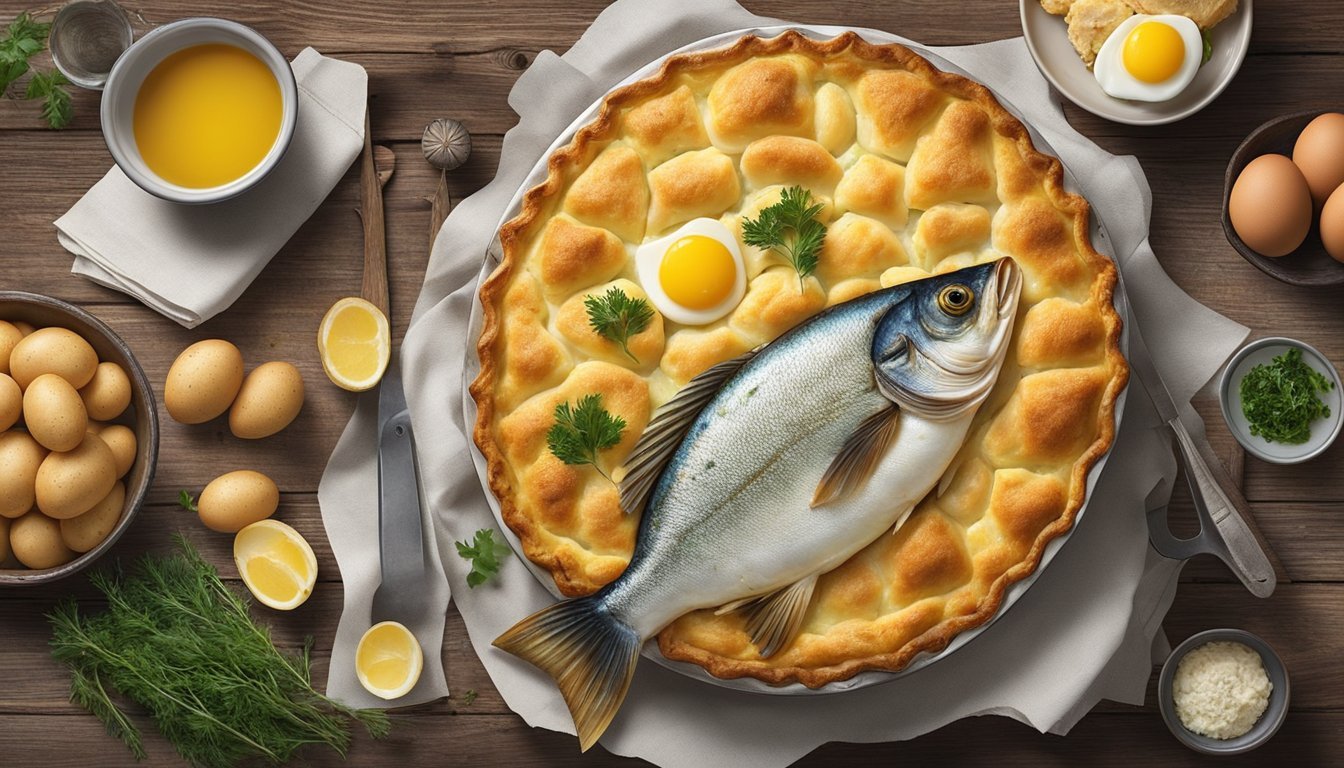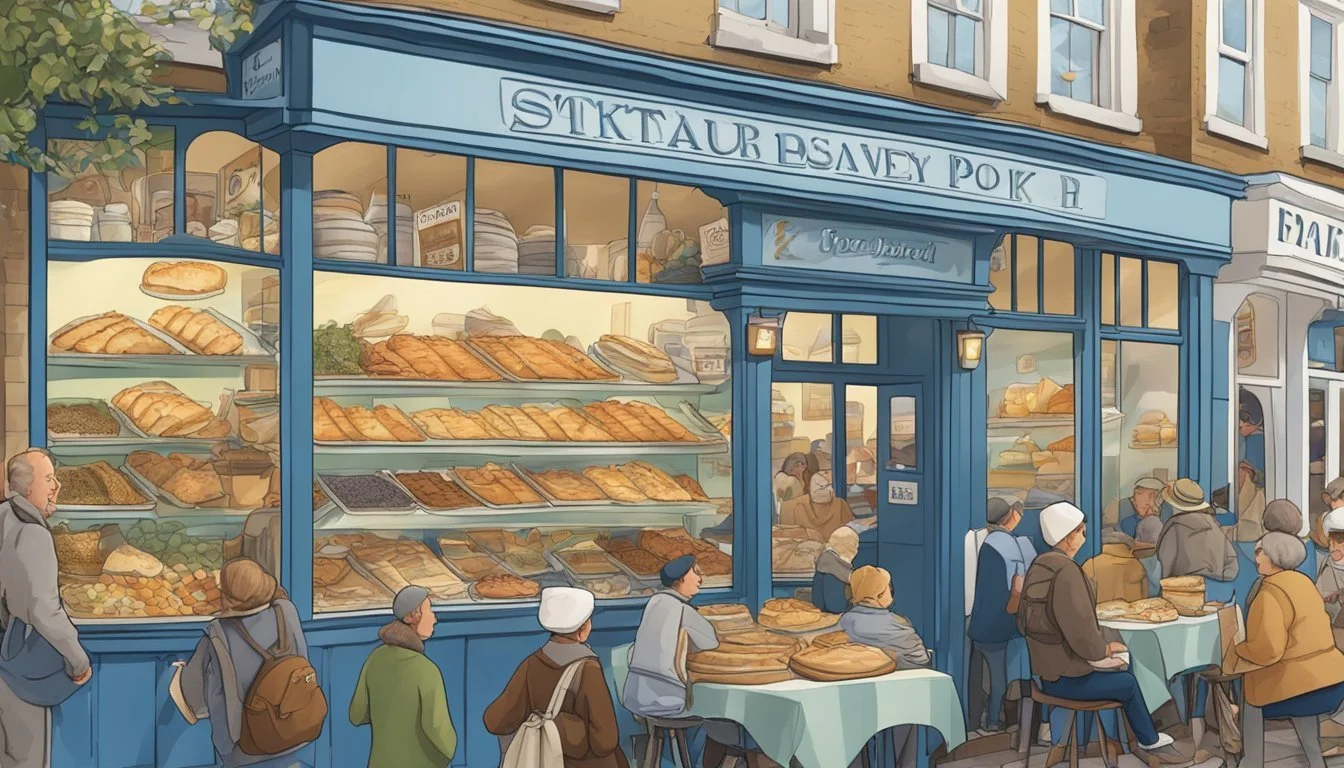Stargazy Pie
Exploring the British Delicacy with Upright Fish Heads
Stargazy Pie stands out in the panorama of British culinary tradition as a celebrated dish from Cornwall, distinct for its presentation of fish heads poking through a golden pastry crust. Steeped in history and originally from the quaint fishing village of Mousehole, this dish is traditionally prepared with pilchards, a type of small sardine commonly found in the waters off the Cornish coast. The fish are baked in the pie with their heads and sometimes tails protruding, appearing to gaze skyward—an homage reflected in the pie's whimsical name.
The construction of the pie is not merely for visual effect; it serves a purpose by allowing the oils released from the cooking fish to flow back into the pie, enriching the flavor of the filling, typically a combination of eggs and potatoes, and enhancing the overall savoriness of the dish. This unique feature positions Stargazy Pie not only as a culinary novelty but also as a reflection of practical ingenuity.
With roots possibly tracing back to a story of survival during a harsh winter when a fisherman named Tom Bawcock braved the stormy seas to bring back enough fish to feed the starving village, Stargazy Pie is a homage to this tale of heroism. Often served at festivities such as Tom Bawcock's Eve, celebrated on December 23rd, the pie embodies both a sense of community and the rich maritime heritage of Cornwall, making it a representative icon of regional British cuisine.
The Historical Significance
The unusual yet charming tradition of Stargazy Pie is deeply rooted in the coastal village of Mousehole, Cornwall, and revolves around the commemoration of a legendary figure, Tom Bawcock. Embracing local folklore, the dish celebrates communal resilience, aligning with a festive ritual that marks a historical event in the village.
Origin in Mousehole
Mousehole, a quaint Cornish fishing village, is credited as the birthplace of Stargazy Pie. This unique dish is a testament to Cornwall's rich maritime heritage. The village itself, with its picturesque harbor and tight-knit community, has long relied on the sea for sustenance and livelihood. Stargazy Pie reflects the resourcefulness of its people, turning the bounty of the ocean into a culinary curiosity that has captivated food enthusiasts.
Tom Bawcock's Legend
Legend has it that Tom Bawcock, a fearless fisherman from Mousehole, braved a relentless storm to catch enough fish to feed the starving villagers. His successful return is said to have been celebrated with a feast where the fish were baked into a pie, heads pointing skyward to symbolize the end of famine. This story underpins the dish, rooting it in themes of courage and community survival.
The Stargazy Pie Festival
Each year on December 23rd, known as Tom Bawcock's Eve, Mousehole honors its hero with a festival that culminates in the serving of Stargazy Pie. This tradition not only memorializes Tom Bawcock's extraordinary deed but also strengthens village bonds and keeps Cornwall's culinary history alive. The festival draws visitors who are keen to partake in the celebration and sample a slice of the legendary pie.
Culinary Roots
Stargazy Pie is a quintessentially Cornish dish that embodies the region's fishing heritage and culinary innovation. Here, we explore the dish's origins within Cornish cuisine and how it has evolved over time.
Cornish Cuisine
Cornwall, nestled in the southwest corner of England, boasts a rich tradition in seafood, given its extensive coastline and fishing legacy. Stargazy Pie centers around seafood, highlighting the locality's abundant resource – fish. The dish's key ingredient, pilchards (or sardines), are a nod to the historical importance of fishing to Cornish communities.
Evolution of the Dish
The dish has endured and adapted over the centuries. While the fundamentals of Stargazy Pie have remained unchanged – fish heads protruding through a pie crust to gaze at the stars – there have been variations in the fish species used and the accompanying ingredients. Potatoes and eggs often complement the fish within the pie, creating a hearty meal that has gained a celebratory status over time.
Ingredients and Preparation
The making of Stargazy Pie involves a unique selection of seafood and a combination of classic pie ingredients that create a distinctive and traditional British dish.
Types of Fish Used
Traditionally, Stargazy Pie is made with pilchards, a type of small sardine. However, it is not uncommon to see variations using other types of fish such as mackerel or haddock. The fish are positioned with their heads protruding through the crust, giving the pie its characteristic appearance.
Key Ingredients
The pie's filling typically contains:
Onions and potatoes, providing a base of flavor and texture.
Eggs and bacon, which add richness and depth to the pie.
Butter and cream, essential for creating a smooth filling.
Fresh parsley and other herbs along with lemon, salt, and pepper are used for seasoning.
Shortcrust pastry serves as the pie casing, encasing the ingredients and fish heads.
Milk is often mixed with mustard to brush the pastry for a golden finish.
For added creaminess, some recipes may include mashed potato within the filling.
The pie generally eschews heavier ingredients, opting for a balance between the savory fish and the more neutral-tasting potatoes and onions.
Cooking Process
To assemble Stargazy Pie:
Prepare the fish: Clean and debone the fish, leaving the heads and tails intact.
Create the filling: Sauté onions and bacon until soft. Add flour to thicken, then mix in stock and cream to form a rich sauce. Combine with herbs, diced boiled potatoes, and fish.
Fill the pie: Line a pie dish with shortcrust pastry, add the filling, and arrange the fish heads so they are peeking out.
Bake: Typically, bake the pie at 200°C (392°F) or 180°C (356°F) for fan ovens. Brush the crust with an egg and milk mixture, then place in the oven for approximately 40 minutes, until the pastry is golden brown.
Visual and Taste Profile
Stargazy Pie is a traditional British dish that immediately catches the eye with its unique presentation. Through a blend of creativity and custom, it offers an intriguing flavor experience that has secured its place in the annals of British cuisine.
Presentation of the Dish
Stargazy Pie presents an eye-catching spectacle as it comes to the table. The main attraction is the sardine heads (and sometimes tails) that poke through the golden pastry lid, appearing to look towards the sky. This peculiar feature is not only traditional but also tells a visual tale of the pie's maritime heritage.
Unique Features
Fish Heads: Served with their heads intact, the fish are placed in such a way that they seem to gaze at the stars, a nod to the dish's name.
Pastry Lid: A buttery crust encases the pie, punctured purposely to showcase the protruding features.
Flavor Combinations
The pie's flavor profile is as distinctive as its appearance. The filling typically includes:
Sardine Heads: Flavorful and rich, they contribute to the overall savory taste of the pie.
Hard-boiled Eggs and Potatoes: These add texture and earthiness to balance the strong flavors of the fish.
A mustard-flavored custard: This can sometimes be included to bind the ingredients and infuse the dish with a tangy creaminess.
Every bite merges the sea's brininess from the sardines with the comforting familiarity of eggs and potatoes, all enveloped in a crispy pastry. The dish may have achieved fame on platforms like the Great British Menu, but it remains an authentic experience of Cornwall's culinary tradition.
Cultural and Social Impact
Stargazy pie has etched its presence within British culture, particularly for its association with the Cornish village of Mousehole and the legendary tale linked to it. This dish, while unique in its presentation with fish heads peering through a pastry crust, resonates deeply with festive traditions and has influenced various forms of cultural expression.
Stargazy Pie in Literature and Media
Literature and media have embraced Stargazy pie, with references to it appearing in cookbooks and television programs. For instance, the Great British Menu, a popular BBC show, once spotlighted the dish as a main course to showcase British culinary heritage. This inclusion underscores the pie's enduring relevance and the artistic and folkloric canvas it provides for storytellers and chefs alike.
Modern Celebrations and Receptions
In Cornwall, Stargazy pie isn't merely a culinary oddity—it is a centerpiece of communal celebration. Each December 23rd, Mousehole honors Tom Bawcock's Eve, an event immortalized by the pie's consumption, symbolizing communal resilience against hardship. Contemporary chefs have taken creative liberties by modifying the traditional recipe, which once strictly used sardines, to include a variety of fish like mackerel and haddock. These reinterpretations both preserve and evolve the dish's significance in Cornish cultural events, ensuring that Stargazy pie remains a lively part of modern festivities.
Serving and Eating Etiquette
When it comes to indulging in a Stargazy Pie, certain customs and manners are often observed, particularly in the regions where the dish originates. Traditionally associated with Christmas celebrations and the legendary festival at the Ship Inn in Mousehole, the pie has both a festive and communal significance.
Preparation: Before serving, the fishmonger plays a crucial role, as only the freshest fish are to be used. It is common to include pilchards or sardines, as well as sometimes hard-boiled eggs among the ingredients.
Presentation: The pie is brought to the table in its baking dish, often ceramic or cast iron, to maintain the temperature. The protruding fish heads and tails are not only a unique feature but also serve as an assurance of the filling’s authenticity.
Service:
The host typically serves the pie.
Portions are to be cut carefully to ensure each serving contains a portion of the fish heads and tails.
Accompaniments may include vegetables or a simple salad, depending on personal or regional preference.
Eating:
Guests should approach the pie with balanced enthusiasm, appreciating the folklore behind its creation.
The fish heads are not usually consumed but are there to enhance the flavor and experience.
It’s customary to use cutlery to tackle the pie, as it can be quite rich and hot.
Etiquette Tips:
Always wait for the host to serve.
Do not attempt to eat the fish heads.
Enjoy the pie with a sense of merriment befitting its history and celebratory ties.
By respecting these simple guidelines, one can enjoy Stargazy Pie in the manner it was meant to be savored, understanding its role in the cultural and culinary heritage of Cornwall.





